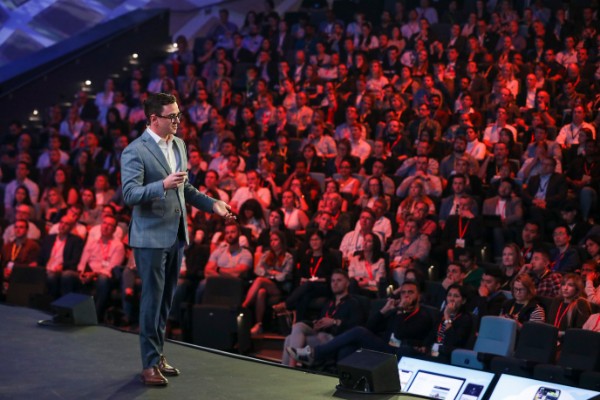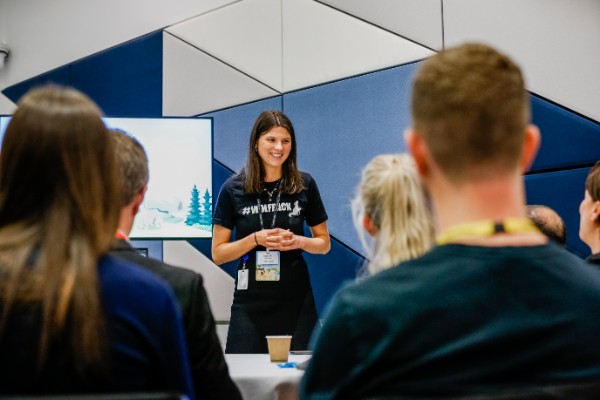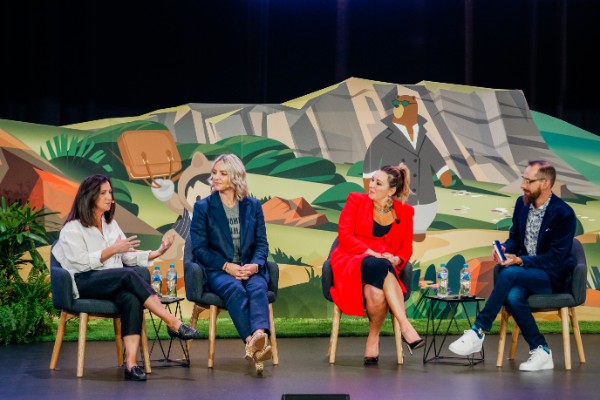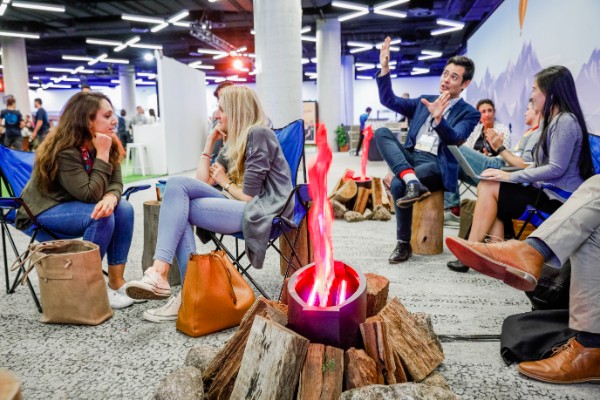Connections to You Sydney showcased incredible service and marketing Trailblazers. Here are the highlights.
1. “We’re all chasing the same holy grail”
In the main keynote, AVP Tony Katsabaris spoke of the increasing importance of a single view of the customer – it’s the holy grail for all of the service and marketing professionals in the room (and for an entire organisation).
“We’re living in a hypermobile connected world,” Katsabaris said. “We’ve never been more connected, and these connections are powering incredible new experiences.”
A stellar example of those incredible experiences came from Kevin Doyle, Regional Vice President – Marketing Automation, who shared a tale that started with calling his mum for parenting advice – ‘bribery is always the answer’ – and ended with him and his partner sitting back, drinking coffee from a machine that ‘people like him’ buy using beans he’d ordered with voice commands, streaming TV while the bribed kid played with a squishy new toy.

Their incredible experience was a moment of relaxation. And for the entirety of it, they thanked one brand that removed friction from every point of their journey.
Parenting lesson: the answer is always bribery, and there’s an app for that. Marketing lesson: removing friction buys loyalty.
2. Success is built on identity
“That best experience you have anywhere? That’s what you expect everywhere,” Doyle said. “Is your company ready for the future expectations of customers?”
Luxury Escapes is. The travel booking company found a few years back that it was struggling with personalisation at scale, and disparate systems were preventing solving the challenge.
Now though, Luxury Escapes has a unifying ID for every customer, and uses clicks not code to pull in data from internal and external sources.
The marketing manager can see, for the first time, that there’s 3.1m people in their database, as well as average lifetime value, top channels, consent across channels, and more.
They can also use AI to find, in moments, an audience they weren’t talking to, create a segment, remove anyone who’s booked recently, publish to activation platforms, and build journeys, using AI to again select the best channel for each interaction.
3. The best financial services marketing is data-driven
Stacey Pence and Rachel Hughes from Accenture’s session on data-driven customer experience for financial services could well have been called ‘What a financial services CMO needs to know now’.
Among financial services CMOs, they shared, 78% believe new market entrants use CX as differentiator and 76% say that those market entrants are beating the traditional players at providing relevant offerings. It’s little wonder then that four out of five see consumers becoming more open to engaging with these new entrants.
“Great CX is key to driving growth, and that relies on leveraging data and aligning tech better,” Pence said. “Business and tech working together is important in making these data-led experiences happen.”
The key attributes for a finserv CMO to be successful – and Pence and Hughes listed some 20 attributes – rely on the smart use of data. That smart use runs from collation and analysis of data to understand the core needs of customers and make the right decisions, through to personalised engagement based on those data-led, AI-powered decisions.

“Personalised engagement isn’t about set personas,” Pence said. “It’s also not sending the same message to everyone, but with the receiver’s first name.”
It’s not disconnected across channels, claims that offers are ‘exclusive’ or data-blind events – think of the last time you returned a product only to receive a ‘personal’ request to review it.
So what is personalised engagement?
“It’s tailored to consumer attributes, behaviours and context,” Pence explained. It adapts as these change and is unified across touchpoints as well as across time and location.
It’s built on actual information about individuals.
“One of the most critical enablers of getting this right is setting up your DMP effectively,” Pence said. This includes ensuring the other tools in your arsenal can do the parts of the heavy lifting that your DMP can’t: storing content, reporting, activating engagement and knowing who your customers are.
Success, Pence and Hughes said, lies with board-level support for and alignment to growth objectives. Their advice for getting this right?
- Break down the silos between business units.
- Establish connections between tech and data leads.
- Align martech with CRM.
- Have patience.
4. You don’t have to spend millions to deliver exceptional customer experience
Imagine flying during monsoon season in Asia and having to walk out onto the tarmac to board your plane. What’s do you wish you had? It seems obvious in retrospect of course.
For Trailblazer AirAsia, discovering that people were getting wet and just didn’t want to was a key insight from its quarterly Customer 360 sessions. In these sessions, AirAsia spends a day with its customers to find out what they like and don’t like about their experiences with the airline, and how they last felt when they flew with AirAsia. Interestingly enough customers said they “felt wet”.
What did AirAsia do? Quickly bought umbrellas to give its passengers as they boarded their flights.
“It just goes to show you don’t have to spend millions of dollars on the biggest thing possible – sometimes it’s just going back to basics. And some people just don’t want to get wet!” explained Bayley Clark, Head of Customer Experience Strategy at AirAsia.
“It’s why we regularly talk to our customers, and we talk to them directly.”
5. Inclusive and authentic marketing is the future
The panel on inclusivity in marketing held approximately 1 billion lessons.
“Why do we have to call it inclusive marketing?” Salesforce’s Jo Gaines asked. “Because it’s hard to change organisations that have been doing things the same way for a long time.”
Jo Gaines, Salesforce Head of Solutions and Product Marketing Derek Laney, Seafolly CMO Adriane McDermott, and Jurlique Global Director, Digital, Data and Ecommerce Fiona Moylan had a pretty honest conversation.
“There is a new era of confidence in women,” said McDermott. “Women today don’t want to be told if and how to look good. They want to look good because they feel good.”
As women and consumers demand brands be more authentic, Gaines is happy to point the finger towards technology and digital for enabling consumers to drive this change. When consumers can reach brands with a tweet or Facebook post, they have the power to call brands out when they’re not being authentic or representing real people.

For Moylan, that means a company needs to have a full view on tone, voice and what the organisation stands for. Otherwise, there will be gaps in the messaging, resulting in an inauthentic voice.
To be inclusive on the outside, brands must be inclusive on the inside. Having just released a new inclusive marketing campaign for Seafolly, titled ‘Own your folly’, McDermott understands the importance of including team members on the journey to inclusivity.
“That is where inclusivity comes in. You need to reflect the goals and values of the entire set of stakeholders behind a brand,” McDermott says. “That does include customers, but it also includes suppliers, team members, your board, the community and other people who are benefiting from the brand.”
Data has played a huge role in helping Jurlique share a more inclusive narrative with customers.
“We have been able to be more creative and more fluid in how we tell our true stories,” Moylan says. “We are starting to talk more about our CSR and the farm.” That’s where many of the herbs, flowers and plants are grown for Jurlique’s natural skincare products. “We didn’t talk about the farm a lot, but we are running straight at that story because it is the truth.”
To launch a new narrative you have to take a few risks; as McDermott found out when her new Seafolly campaign hit the media.
“Women wanted more diversity and more representation of women in Seafolly’s advertising,” she says, “I was so inspired by the feedback that I got back on social media that we ran another shoot with more women.”
As all panel members agreed, inclusive marketing is an ongoing journey with no finish line.
“This is about kindness and treating everyone with respect, no matter the gender,” Jo Gaines said. “As long as brands keep doing their best, that is all we can ask.”
6. Camp out with our customers
As if the inclusive marketing panel wasn’t enough to convince us that our customers are companies with amazing, Trailblazing people in them, it was pretty clear looking around the expo.
The Juice for Good pop-up had a line a mile long, and for good reason. Juice for Good uses rescued oranges – perfectly good on the inside – to make fresh 100% OJ with all profits to OzHarvest.
Jurlique, meanwhile, was offering hand treatments on tap to all attendees with their signature Australian grown products.
Lesson learnt: the Campground is the place to be at Salesforce events!
To find out more about getting closer to your customer, download the State of the Connected Customer report here.























